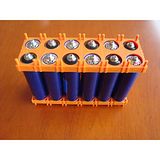There's a vast almost dizzying selection of easy & simple hub kits - generally speaking they're the most straightforward & economical method of converting a bicycle to an electric drive... as with anything there's compromises to be made and with ebikes it's usually speed vs range, fast or far - take your pick lol but your "30mph" isn't unreasonable however, even the inexpensive 48v/1000w hub kits are usually capable of a sustained, flat ground 26+mph...
...the "catch" is with electric vehicles, the
really important investment is in the battery packs - and they are an "investment" in every way. Should you choose wisely, spend the money up front and get a quality LiFePO4 pack with the most amp hours (= range) you can afford, effectively you won't "need to replace batteries" and there is no "cost of upkeep", maintenance or other concerns (like fade or charge memory) and you will most likely be quite well satisfied with your ebike. LiFePO4's usually have from 1000 - 2000 complete charge cycles (slowly tapering off in efficiency/capacity after that) - so even if you fully discharged your pack every day w/the
minimum of 1000 cycles, seven days a week (which is unlikely but still OK as they're protected by a Battery Management System), that'd be almost three years of 100% service. They'd continue to function after that ofc, just at a reduced percentage.
There are alternatives (quite a few actually), but again there's compromises to be made -
Li-Ion (Lithium Ion) batteries for example are also common & somewhat less expensive than
Lithium iron Phosphate (LiFePO4) - but they haven't the thermal and chemical stability of LiFePO4 and tend to have slightly reduced cycle life (500-1000) in comparison to LiFePO4.
To be completely honest, I believe the vast amount of the disappointment some have mentioned regarding electric vehicles can be placed solely on the decision to attempt to save money and use SLA (sealed lead acid) or any variant of lead acid batteries instead - simply put I believe this to be a false economy measure as lead acid batteries tend to be at least twice the weight and a third larger than an equivalent alternative with only 500-800 charge cycles, best case scenario. This vastly reduced energy density, efficiency & short cycle life takes a major toll on the overall preformance of any electric vehicle - "every ounce counts" cannot be overstated with electrics.
You can save a few bucks/get more amp hours for your money by purchasing what's affectionately known as "duct tape packs" BTW (tho these days they're shrink wrapped instead) - they're battery packs assembled specifically for your needs but lacking the shiny case the kits often offer. While you'll need to figure out your own mounting system and/or purchase your own case separately, this inconvenience is offset by lessened cost/increased preformance over the kit batteries and the customization options, such as a single pack split into duals (ability to mount in panniers w/lower weight & balance) and/or the BMS & discharge current/amperage tailored to your specific needs & application etc.
Reference material:
Table of rechargeable battery types
Disclaimer: TBH I still consider myself an ebike novice, the above based only on what R&D I've done for my own projects - forgive any discrepancies please







